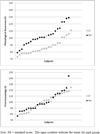Phonological awareness and print knowledge of preschool children with cochlear implants
- PMID: 22223887
- PMCID: PMC3370130
- DOI: 10.1044/1092-4388(2011/11-0086)
Phonological awareness and print knowledge of preschool children with cochlear implants
Abstract
Purpose: To determine whether preschool-age children with cochlear implants have age-appropriate phonological awareness and print knowledge and to examine the relationships of these skills with related speech and language abilities.
Method: The sample comprised 24 children with cochlear implants (CIs) and 23 peers with normal hearing (NH), ages 36 to 60 months. Children's print knowledge, phonological awareness, language, speech production, and speech perception abilities were assessed.
Results: For phonological awareness, the CI group's mean score fell within one standard deviation of the Test of Preschool Early Literacy's (Lonigan, Wagner, Torgesen, & Rashotte, 2007) normative sample mean but was more than one standard deviation below the NH group mean. The CI group's performance did not differ significantly from that of the NH group for print knowledge. For the CI group, phonological awareness and print knowledge were significantly correlated with language, speech production, and speech perception. Together these predictor variables accounted for 34% of variance in the CI group's phonological awareness but no significant variance in their print knowledge.
Conclusions: Children with CIs have the potential to develop age-appropriate early literacy skills by preschool age but are likely to lag behind their NH peers in phonological awareness. Intervention programs serving these children should target these skills with instruction and by facilitating speech and language development.
Figures
References
-
- Anthony JL, Francis DJ. Development of phonological awareness. Current Directions in Psychological Science. 2005;14(5):255–259.
-
- Bird J, Bishop DVM. Perception and awareness of phonemes in phonologically impaired children. European Journal of Disorders of Communication. 1992;27:289–311. - PubMed
-
- Blamey PJ, Barry JG, Bow CP, Sarant JZ, Paatsch LE, Wales RJ. The development of speech production following cochlear implantation. Clinical Linguistics and Phonetics. 2001;15(5):363–382.
-
- Boothroyd A, Eisenberg LS, Martinez AS. VIPSPAC (Version4.3) Los Angeles, CA: House Ear Institute; 2006.
-
- Boudreau D. Use of a parent questionnaire in emergent and early literacy assessment of preschool children. Language, Speech, and Hearing Services in Schools. 2005;36(1):33–47. - PubMed
Publication types
MeSH terms
Grants and funding
LinkOut - more resources
Full Text Sources
Medical


